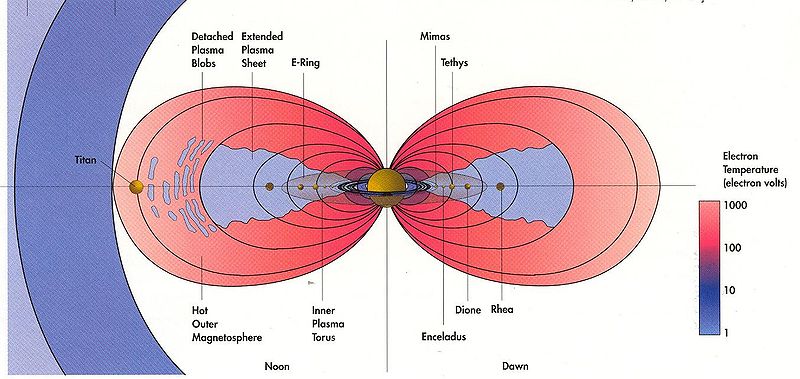
Have you ever wondered why Titan, the largest moon of Saturn, has a dense atmosphere?
Unlike any other moon in our solar system, Titan’s atmosphere is mostly nitrogen-rich and has a significant amount of methane.
In this blog post, we will take a deeper look into Titan’s atmospheric composition and explore the reasons behind its unique features. We will also discuss the role that Saturn’s magnetic field plays in shaping Titan’s atmosphere and how atmospheric circulation works on this fascinating moon.
So, if you are curious about what makes Titan stand out from the rest of the moons in our solar system, keep reading!
Understanding Titan’s Atmospheric Composition
Titan’s atmospheric composition is a fascinating subject to explore. Similar to Earth’s atmosphere, Titan’s atmosphere is primarily composed of nitrogen, making it an intriguing celestial body in our solar system.
What sets Titan apart is the presence of organic molecules in its atmosphere, hinting at the potential for life to exist beyond our own planet. The instruments of the Huygens probe found Titan’s nitrogen isotope ratio most resembles that found in a very substantial portion of comets in the Oort Cloud. This means that most of that nitrogen was brought to Titan by such comets.
The dense atmosphere on Titan is a result of several factors. Firstly, Titan’s gravity allows it to retain its atmosphere more effectively compared to other moons in our solar system. Additionally, the extreme cold temperatures also contribute to the thickness of its atmospheric layers. Finally, Saturn’s magnetosphere protects its moon’s atmosphere from being stripped away by solar winds. The combination of these factors creates a unique and substantial atmosphere surrounding the moon.
In addition to nitrogen, Titan’s atmosphere also contains trace amounts of other hydrocarbons, such as methane and ethane. These hydrocarbons contribute to the complex chemistry occurring within the atmosphere, further enhancing its potential for hosting biological processes.
An interesting aspect of Titan is its atmospheric pressure, which is approximately 50% higher than Earth’s, despite the lower gravity. This higher surface pressure, coupled with the presence of various organic materials, creates an environment that is quite different from what we are accustomed to here on Earth.
Understanding the atmospheric composition of Titan is crucial in unraveling the mysteries of this fascinating moon of Saturn. By studying its atmosphere, scientists can gain insights into its overall habitability and whether it could potentially support life, albeit in a vastly different form. Various missions, including the Cassini orbiter and the Huygens probe as well as the Hubble Space Telescope, have provided invaluable data about Titan’s atmospheric characteristics.


Why Does Titan Have Such a Nitrogen-Rich Atmosphere?
Titan’s nitrogen-rich atmosphere is believed to be the result of its formation process. At that time, nitrogen was already present in the moon’s building blocks, however with a significant addition from Oort cloud comets. The absence of an atmosphere-stripping solar wind and the presence of water ice on the surface of Titan have allowed it to retain its nitrogen-rich atmosphere. Valuable data from the Huygens probe has contributed to our understanding of Titan’s atmospheric composition.
The Role of Methane in Titan’s Atmosphere
Methane plays a critical role in shaping the unique atmosphere of Titan. Its presence creates a greenhouse effect, trapping heat and maintaining temperatures on the moon’s surface. This is similar to how greenhouse gases like carbon dioxide work on Earth. The greenhouse effect produced by atmospheric methane on Titan contributes to its relatively warm temperature, despite being located in the outer solar system. On December 1, 2022, astronomers reported viewing clouds moving across Titan, likely made of methane, using the James Webb Space Telescope.
In addition to its role in temperature regulation, methane undergoes complex chemistry in Titan’s atmosphere, leading to the production of organic aerosols. These aerosols contribute to the moon’s hazy appearance and are responsible for the scattering of visible light and the orange color observed on the moon’s surface.
The interaction between sunlight and methane in Titan’s atmosphere also leads to the formation of complex organic molecules. This process is of great interest to scientists studying the possibility of life beyond Earth, as it provides insights into the potential for the creation of organic material in extraterrestrial atmospheres.
Studying the methane cycle on Titan is not only important for understanding the moon itself but also provides valuable insights into Earth’s climate system. By studying the dynamics of methane in Titan’s atmosphere as well as the liquid methane on the surface, scientists can gain a better understanding of how greenhouse gases affect climate and weather patterns.
The Influence of Titan’s Magnetic Field on its Atmosphere
Unlike Earth, Titan does not possess a significant magnetic field. This distinctive characteristic allows solar radiation to directly interact with Titan’s atmosphere, which is not the case on our own planet. As a result of Titan’s lack of a strong magnetic field, its atmosphere reaches far into space, extending beyond what one might expect.
Furthermore, in the case of Titan (which doesn’t even have much metal in its rocky core), a gas giant with a powerful magnetic field comes to the rescue and protects its atmospheres from the adverse effect of solar wind. The absence of a magnetic field has another intriguing consequence: the interaction between Titan and Saturn’s magnetic field.


This interaction is responsible for the ionization of Titan’s upper atmosphere, resulting in the creation of an ionosphere. Through this process, the upper atmospheric layers become charged and influenced by the powerful magnetic field of its parent planet, Saturn. The ionosphere plays a vital role in shaping the dynamics of its atmosphere and understanding its behavior.
To gather valuable data regarding the interaction between Titan’s atmosphere and Saturn’s magnetic field, scientists relied on the Cassini spacecraft, a joint project of the European Space Agency (ESA) and NASA’s Jet Propulsion Laboratory. The Cassini orbiter provided invaluable insights into this unique relationship and helped expand our understanding of the complex interplay between celestial bodies within the solar system. By studying the magnetic influence of Saturn on Titan’s atmosphere, researchers can better comprehend the intricate dynamics taking place within the moon’s atmospheric layers.
How does Titan’s Atmospheric Circulation Work?
Titan’s atmospheric circulation is driven by a combination of solar heating and the moon’s rotation. The presence of surface features, like lakes and dunes, affects the circulation patterns. Wind patterns on Titan are slower and more predictable due to its thick atmosphere, which can lead to the formation of intense and short-lived brightenings in the infrared known as Titanian dust storms. This circulation transports organic molecules and shapes the moon’s surface, providing insights into weather patterns on other celestial bodies.
Frequently Asked Questions
How can Titan keep an atmosphere when it is only slightly larger than airless Mercury?
The planet Mercury, being so close to the Sun, is constantly being bombarded by solar wind that strips away its atmosphere, leaving behind only trace amounts. Mercury’s tiny magnetosphere is insufficient to provide protection. Just like Mercury, Titan also doesn’t have much of a magnetosphere, but is shielded by the much stronger magnetosphere of Saturn.
Why is Titan able to hold an atmosphere, despite being smaller than Mars?
Titan’s ability to hold an atmosphere, despite its smaller size compared to Mars, can be attributed to several factors. The distance from the Sun plays a major factor. The further a celestial body is from the Sun, the less solar wind to strip off the atmosphere. Mars has a very weak magnetosphere, meanwhile Titan is protected by Saturn’s magnetosphere.
Why does Titan have an atmosphere but not the Moon?
Unlike the Moon, Titan has a thick atmosphere because it’s protected by Saturn’s magnetic sphere, in addition to its own tiny magnetosphere. The Moon does not enjoy such protection and so its tiny atmosphere is constantly being stripped away by the solar wind.
What makes Titan’s atmosphere so unique compared to other moons in our solar system?
Titan’s atmosphere stands out among other moons in our solar system due to its density and composition. Primarily made up of nitrogen, with traces of methane and other gases, it creates a greenhouse effect that makes Titan’s surface temperature much warmer. Furthermore, the presence of organic molecules in the atmosphere makes Titan an intriguing location for studying the origins of life.
How did Titan develop such a thick atmosphere despite its relatively low gravity?
Titan’s thick atmosphere is a result of its distance from the sun and composition. Methane and nitrogen are the main components and they are constantly replenished by geological activity. Protection from the solar wind by Saturn’s magnetosphere is another major factor. Being the second largest moon in the entire solar system helps too.
What role does Saturn, the planet that Titan orbits, play in maintaining its dense atmosphere?
Saturn, the planet that Titan orbits, plays a crucial role in maintaining its dense atmosphere. The interaction between Saturn’s magnetic field and Titan’s atmosphere protects it from solar wind and creates a dynamic environment that contributes to its atmospheric density.
Conclusion
In conclusion, Titan’s dense atmosphere is a result of its unique composition and environmental factors. The high concentration of nitrogen in its atmosphere is one of the main reasons for its density. Additionally, the presence of methane plays a significant role in shaping the chemistry and temperature of Titan’s atmosphere. The interaction between Saturn’s magnetic field and Titan’s atmosphere also contributes to its density.
Studying Titan’s atmosphere provides valuable insights into the complexities of planetary atmospheres and helps us understand the conditions necessary for sustaining life in a habitable environment. Further research and exploration will continue to reveal fascinating details about this enigmatic moon and its potential for supporting life beyond Earth.